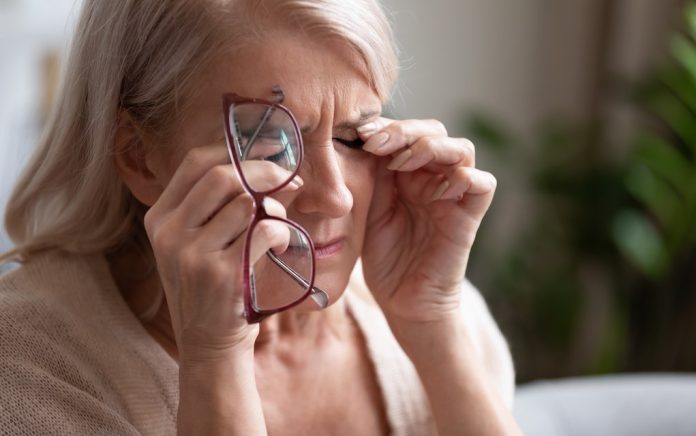
Imagine going to bed at night with good vision and waking up in the morning with significant to severe vision loss in one eye. That’s what happens to about 6,000 people per year in the United States, and the condition is known as nonarteritic anterior ischemic optic neuropathy, or NAION.
Actually, there are two types of ischemic optic neuropathy (ION): anterior (swelling of the optic nerve head; the more common type) and posterior (no swelling). Both types can be further divided into arteritic (caused by giant cell arteritis), nonarteritic (noninflammatory cause), and perioperative. Since nonarteritic anterior ischemic optic neuropathy is the form that occurs most often, it is the focus of our discussion.
Read about 20 important nutrients to support your vision
What is nonarteritic anterior ischemic optic neuropathy?
NAION is a major cause of significantly impaired vision or blindness. It typically affects people older than 50 who also have an underlying condition that affects the blood vessels, such as high blood pressure, high cholesterol, or diabetes. However, not everyone who develops NAION has vascular problems. Other conditions associated with NAION include smoking, obstructive sleep apnea, anemia, migraine, ocular and nonocular surgery, and use of certain medications (e.g., dopamine, adrenalin) or phosphodiesterase type-5 inhibitors (e.g., Viagra, Cialis).
People who develop NAION usually discover it when they wake up in the morning, and the vision loss is painless. Experts have named a few possible causes of NAION, which is believed to be the result of a temporary disruption in the circulation of the optic nerve head, resulting in reduced blood flow and tissue damage.
The cause of this temporary circulation problem may be nocturnal hypotension (low blood pressure; BP typically gets lower at night), vasospasm (sudden constriction of a blood vessel), venous occlusion (blocked or narrowed vein), thrombosis (clot), or a similar event. In addition, some people may be predisposed to NAION because they have a “crowded optic disc head,” which means there is a structural reason near the optic nerve head that explains the disruption in blood flow.
One study found that high levels of homocysteine and lipoprotein(a) along with low levels of vitamin B6 may increase a person’s risk of developing NAION. Another risk factor for NAION appears to be obstructive sleep apnea, as up to 80 percent of individuals with this vision problem also are affected by sleep apnea.
Read about can cannabinoids treat sleep apnea?
NAION: Treatment and prognosis
About 40 percent of individuals who have NAION will experience spontaneous improvement in visual acuity without receiving any treatment. This is promising news for those who want to avoid conventional treatment, which typically includes corticosteroids and aspirin, both of which have not proven very effective. Anyone who is taking antihypertensive medication should talk to their doctor about taking it in the morning rather than at night.
Because no effective treatment is available currently and little research has been done on natural remedies, lifestyle changes are suggested. According to Andrew G. Lee, MD, chair of the department of ophthalmology at Methodist Hospital and professor of ophthalmology, neurology, and neurosurgery at Weill Cornell Medical College in Houston, individuals with the eye condition are encouraged “to eat a good diet, do a moderate amount of exercise and not to smoke. We ask about sleep apnea,” which should be managed.
Acupuncture may prove helpful for some patients. In a study appearing in Evidence-Based Complementary and Alternative Medicine, 69 individuals with NAION were treated with acupuncture for a total of 8 weeks. Visual acuity improved 74.19%, 78.89%, and 81.7% after 2, 4, and 8 weeks of treatment, respectively. The authors of the study concluded that “acupuncture treatment could obviously improve the visual function of patients with NAION and be used as complementary and alternative therapy in clinic.”
Bottom line
Nonarteritic anterior ischemic optic neuropathy (NAION) may be a painless condition, but the lack of effective treatments can be frustrating for those affected by this vision problem. However, the good news is that healthy lifestyle modifications and addressing any related underlying medical conditions such as diabetes and high cholesterol may be helpful and that the condition does improve in about 40 percent of cases.
Sources
Berry S et al. Nonarteritic anterior ischemic optic neuropathy: cause, effect, and management. Eye and Brain 2017; 9:23-28
Foroozan R. New treatments for nonarteritic anterior ischemic optic neuropathy. Neurology Clinic 2017; 35:1-15
Giambene B et al. Evaluation of traditional and emerging cardiovascular risk factors in patients with non-arteritic anterior ischemic optic neuropathy: A case-control study. Graefe's Archives of Clinical and Experimental Ophthalmology 2009; 247(5): 693-97
Hayreh SS et al. Nonarteritic anterior ischemic optic neuropathy: role of nocturnal arterial hypotension. Archives of Ophthalmology 1997; 115(7):942–945.
Qin Y et al. Clinical efficacy observation of acupuncture treatment for nonarteritic anterior ischemic optic neuropathy. Evidence-Based Complementary and Alternative Medicine 2015; article ID 713218
Stephenson M. Diagnosing and managing ischemic optic neuropathy. Review of Ophthalmology 2010 Oct 9
Subramanian PS. NAION: what to do and when. Glaucoma Today 2019 Jan-Feb










